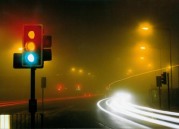Consistency Examples (Item 1&2 / Q2 Examples)
I’ll be delivering three (3) examples of consistency, the specific principles of consistency will range from aesthetic-consistency to functional-consistency. To begin, I’ll be using the example of the traffic light. The traffic light is an example for the functional consistency principle, as we are aware of the meaning behind what the traffic light is there for. The traffic light is an object in which it indicates to vehicles whilst on the road when to stop, go or slow-down when approaching joint roads that clash. How the traffic lights are controlled, as explained from the Brisbane City Council’s (2008) ‘Roads & Traffic Fact Sheet’; “Traffic lights are controlled by a local computer at each intersection and is networked for remote access by traffic engineers or officers […]”.
The second (2nd) example is that of the light switch. The light switch is a little switch within a room that turns on the light, it is associated with the aesthetic-consistency principle. Reason being is because when we know of the appearance of a light switch and the placement within a room. The Fun Times Guide (2012) states the placement of a light switch “You should place all light switches on the latch side of a door, not the hinge side. This makes it easier to access the lights as you walk in or out of a room.” When we enter a dark room, we tend to feel around the side of a doorway for a light switch, we know aesthetically what the light switch would ‘feel’ like, ‘look’ like and what its purpose is.
The final example is extracted from Lidwell, Holden & Butler’s (2003) ‘Universal Principles in Design’, and the example highlighted is the internal-consistent ‘Signs within a park’. Signs within a park are consistent with each other as they show the same purpose, to indicate to the visitor where a certain place is, what to look out for, where to go and so on. All of the information is confined within the same area, thus they’re connected with each other. Same can be said about signs within a ‘zoo’ or a ‘golf course’, each have the same criteria and purpose, delivering the same information only in a new setting.
– – –
Brisbane City Council. (2008). Roads & Traffic Fact Sheet. Traffic Lights. (pp. 1-4).
Lidwell, W., Holden, K., & Butler, J. (2003). Aesthetic-Usability Effect. In Universal Principles of Design. (p. 46).
The Fun Times Guide. (2012). Where Should You Put Your Light Switches?. Retrieved from http://log-homes.thefuntimesguide.com/2007/01/placement_of_light_switches.php


